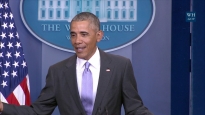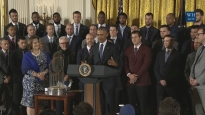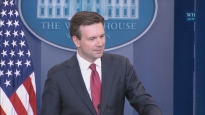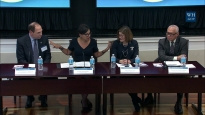The First Lady Speaks to American Servicewomen
March 3, 2009 | 11:38
First Lady Michelle Obama visited Arlington National Cemetery's Women in Military Service for America Memorial Center on March 3, 2009. This event is in honor of Women's History Month and is an extension of Mrs. Obama's focus on military families. (public domain)
Download mp4 (42MB)
FLOTUS Pool Report and Remarks from Arlington Nat'l Cemetery Women's Memorial Event
THE WHITE HOUSE
Office of the First Lady
________________________________________________________________
For Immediate Release March 3, 2009
________________________________________________________________
For Immediate Release March 3, 2009
REMARKS BY THE FIRST LADY
AT THE WOMEN IN MILITARY SERVICE FOR AMERICA MEMORIAL CENTER
AT THE WOMEN IN MILITARY SERVICE FOR AMERICA MEMORIAL CENTER
Arlington National Cemetery
Arlington, Virginia
Arlington, Virginia
2:30 P.M. EST
MRS. OBAMA: All right, you're all invited. (Laughter.) No, I think that's an excellent idea. Jocelyn, where are you? She's my policy director. She'll be working on that. (Laughter.)
I want to thank the General for that kind introduction, and to thank her for her lifetime of service to this nation in the United States Air Force and as the leader of the Women in Military Service for America Memorial. I just did a tour with the General, and this is an amazing asset to this nation. It's something that many of us don't even know exists, and I could have spent hours there.
I strongly encourage anyone in this country who hasn't taken the time to see this memorial. It goes through the whole progression of women into the military, with contributions from family members from around this country, pictures, uniforms. I'm going to spend more time here and bring my girls, because it is something that I want them to see. So I'm grateful to have the opportunity to see this, and will be working hard to make sure that this memorial continues to be a part of this nation's heritage. (Applause.)
I also want to thank a few people, as well. I want to thank General Dunwoody, the nation's first female four-star general, which deserves its own round of applause -- (applause); Vice Admiral Vivien Cray of the United States Coast Guard -- and I know there a few Coast Guards out there; I heard you -- (applause); and to Congresswomen Mary Fallin, as well as Laura Richardson and my hometown congressperson Jan Schakowsky. (Applause.) I also have to recognize someone else from home, our good friend, dear dear friend, Tammy Duckworth. (Applause.) It's good to see you. (Applause.)
I am honored to be here with you all. As the General said, of course this is -- this month is Women's History Month, and it provides an opportunity for Americans to discover and reflect on the accomplishments of women throughout our nation's history.
But it provides an opportunity to celebrate the many contributions women make today in national life as leaders in business, government, the community, the military, and of course in everyday life, which is how we women live, mostly as mothers, daughters, wives, colleagues and friends. And I couldn't think of a better way to begin Women's History Month than by coming here to the Women's Memorial at Arlington National Cemetery to honor our nation's servicewomen.
As I speak, servicewomen and men are at their posts all across our nation and around the world. They're standing watch and providing the security that allows us to live in peace and to continue on with our daily lives.
That includes two whom I have just met -– Lieutenant Grace Thompson and Corporal Crystal Moultrie of the United States Marines. We keep them, the wounded who are recovering, and those who gave the ultimate sacrifice, so that we may live in safety and freedom, we keep them in our thoughts and our prayers.
Throughout our nation's history, women have played an important role in the military as well as in organizations supporting the military during times of conflict. Our foremothers and our sisters today have joined our forefathers and our brothers today in securing our liberty and protecting our country.
Women's military service goes back to America's early beginnings, and servicewomen have long navigated the twists and turns of the women's rights struggle to secure a more equal and fuller place in the United States military.
This history was interesting to me. In 1782 Deborah Sampson disguised herself and enlisted in the Fourth Massachusetts Regiment. She was wounded at the Battle of Tarrytown in New York. Later, she appealed for back pay as a former Continental Army soldier and was supported by Paul Revere. The measure was passed by the Massachusetts legislature and approved by the governor, John Hancock.
Then there was Dr. Mary Edwards Walker, a military doctor, who became the nation's first female Medal of Honor recipient for her service during the Civil War.
And then we moved to the 20th century, where women became full-fledged members of the United States military with the creation of the Army and Navy Nurse Corps in 1901 and 1908.
And we are joined here today by two amazing women -- they gave me their ages, but there's no reason to know, because they look about 30, 40, to me -- (laughter) -- Mary Ragland and Alice Dixon, who served in the "Six-Triple Eight," the only unit of African American women in the Women's Army Corps to serve overseas during World War II. Please give them a round of applause. I know Mary is here. (Applause.) Spring chickens. (Laughter.) And if you live right, you may be sitting right there in a few decades. (Laughter.)
There's also Esther Corcoran, who is also with us, enlisted as a private in the Women's Army Auxiliary Corps and was later entered into Officer Candidate School. She was eventually promoted to Lieutenant Colonel, one of the first 10 women to achieve this rank. (Applause.)
Currently serving her country is Lieutenant Commander Cindy Campbell. She began her Navy career as an E1, served at sea and on the homeland. She put herself through college and graduate school at night and became an officer. She now works in the White House Military Office, right outside my office in the East Wing. Cindy serves as a mentor to servicewomen and men in earlier stages of their careers, and I and my staff benefit from her expertise and dedication every day. Cindy, where are you? She's way in the back. (Applause.)
These women and thousands of others set a standard for excellence that enables women who serve today to take on even greater responsibilities.
A recent Women's Memorial Women's History Month poster is called "Voices of Valor" and spotlights five decorated servicewomen from each of the Armed Forces who've served or are serving in the current war.
One is Silver Star recipient Sergeant Lee Ann Hester. She's the first woman to have been decorated for direct actions against an enemy force.
There's also Lieutenant Lisa Starr [sic], a United States Navy Nurse, who volunteered for a nighttime flight in Iraq during a sandstorm that had grounded all medical helicopters to save the life of a wounded Marine.
And there's Fighter pilot Captain Kim Campbell, who displayed extraordinary skill at the controls of her aircraft to support and protect the lives of her fellow soldiers fighting on the ground in Iraq.
There's Second Class Marine Science Technician Sarah Vega, who served in both Iraq and Afghanistan and is an example of the bravery that men and women of the United States Coast Guard are displaying in war zones today.
And then Marine Corporal Ramona Valdez who, in addition to her other duties, was teamed up with 16 other servicewomen to form an all-female search force in Iraq as a proactive effort to calm Iraqi concerns that male soldiers might search Muslim women. Her convoy was attacked and she was killed four days before her 21st birthday.
Marine Major General Douglas O'Dell Jr. wept as he awarded Purple Hearts to the survivors from Corporal Valdez's force. He said he was moved, I quote, "not by special sympathy for the women" but because of the display of equality born of that horrible day in Fallujah. The general went on to explain that while military leaders believed women Marines could perform as bravely as men under deadly attack, there had never been a trial like the one in Fallujah to prove it.
Members of the military and their families have a special courage and strength. As the President said last week during his address at Camp Lejeune, service doesn't end with the person wearing the uniform. You all know that.
And I have been honored and deeply moved to meet many military families over the past couple of years. They are mothers and fathers who have lost their beloved children to war. They are husbands and wives keeping the family on track while their wives and husbands are deployed, on duty. They are grandparents, aunts and uncles, sisters and brothers who are taking care of children while single moms or dads in uniform are away.
And there are moms and dads who both serve in uniform -- like helicopter pilots Colonels Laura and Jim Richardson who in 2003 became the first couple to have led their own battalions during a time of combat. And during that time, they were able to leave their 14-year-old daughter in the care of family when they were deployed.
See, military families have done their duty, and we as a grateful nation must do ours. We must do everything in our power to honor them by supporting them; not just by word but by deed.
And it is my great hope that today's and future generations will honor women and men in uniform by first of all never taking the blessings of freedom for granted and by doing their part to create a more perfect union. I know that we will continue to do our parts over the coming years.
Again, I want to thank you all for your service, for your courage, for your dedication, for your commitment. And may God bless you all, and God bless America. Thank you so much. (Applause.)
END
2:42 P.M. EST
2:42 P.M. EST
|
January 18, 2017
|
January 17, 2017
|
January 16, 2017
|
January 16, 2017
|
|
January 14, 2017
|
January 13, 2017
|
January 13, 2017
|
January 12, 2017
|







